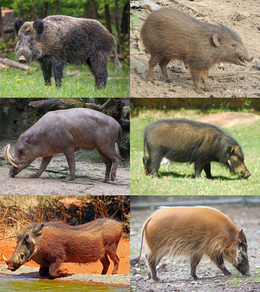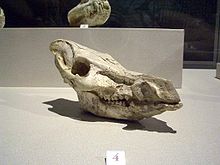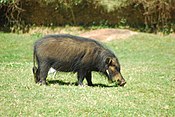Suidae
| Suidae Temporal range:
| |
|---|---|

| |
| Suid species of different genera; from top-left, clockwise: Wild boar (Sus scrofa), pygmy hog (Porcula salvania), giant forest hog (Hylochoerus meinertzhageni), red river hog (Potamochoerus porcus), common warthog (Phacochoerus africanus), North Sulawesi babirusa (Babyrousa celebensis) | |
| Scientific classification | |
| Domain: | Eukaryota |
| Kingdom: | Animalia |
| Phylum: | Chordata |
| Class: | Mammalia |
| Order: | Artiodactyla |
| Suborder: | Suina |
| Family: | Suidae Gray, 1821 |
| Type genus | |
| Sus Linnaeus, 1758
| |
| Genera | |
|
Over 30 extinct genera, 6 extant, | |
Suidae is a
The earliest
Physical characteristics
Suids belong to the
They are small to medium animals, varying in size from 58 to 66 cm (23 to 26 in) in length, and 6 to 9 kg (13 to 20 lb) in weight in the case of the pygmy hog, to 130–210 cm (4.3–6.9 ft) and 100–275 kg (220–606 lb) in the giant forest hog.[4] They have large heads and short necks, with relatively small eyes and prominent ears. Their heads have a distinctive snout, ending in a disc-shaped nose. Suids typically have a bristly coat, and a short tail ending in a tassle.[citation needed] The males possess a corkscrew-shaped penis, which fits into a similarly shaped groove in the female's cervix.[5][6][7]
Suids have a well-developed sense of hearing, and are vocal animals, communicating with a series of grunts, squeals, and similar sounds. They also have an acute sense of smell. Many species are omnivorous, eating grass, leaves, roots, insects, worms, and even frogs or mice. Other species are more selective and purely herbivorous.[3]
Their teeth reflect their diet, and suids retain the upper
Behavior and reproduction

Suids are intelligent and adaptable animals. Adult females (sows) and their young travel in a group (sounder; see List of animal names), while adult males (boars) are either solitary, or travel in small bachelor groups. Males generally are not territorial, and come into conflict only during the mating season.
Litter size varies between one and twelve, depending on the species. The mother prepares a grass nest or similar den, which the young leave after about ten days. Suids are weaned at around three months, and become sexually mature at 18 months. In practice, however, male suids are unlikely to gain access to sows in the wild until they have reached their full physical size, at around four years of age. In all species, the male is significantly larger than the female, and possesses more prominent tusks.[3]
Classification

The following 18
| Image | Genus | Living species |
|---|---|---|
 |
Sus – pigs |
|
 |
Porcula |
|
 |
Hylochoerus |
|
 |
Potamochoerus |
|
 |
Phacochoerus – warthog |
|
 |
Babyrousa – babirusa |
|
Phylogeny
Cladogram of Suidae. Mikko's Phylogeny Archive (Based is McKenna & Bell, 1997, Liu, 2003 и Harris & Liu, 2007):[9]
| ||||||||||||||||||||||||||||||||||||||||||||||||||||||||||||||||||||||||||||||||||||||||||||||||||||||||||||||||||||||||||||||||||
References
- ISBN 1-84028-152-9.
- ISBN 0-8160-1194-X.
- ^ ISBN 0-87196-871-1.
- ^ "Forest hog (Hylochoerus meinertzhageni) - Quick facts".
- ISBN 978-1-4757-8982-9.
- ISBN 978-0-7020-2828-1.
- ISBN 0-8014-1753-8.
suidae penis.
- ISBN 978-8496553774.
- ^ "SUIDAE – pigs". Mikko's Phylogeny Archive. Archived from the original on 2021-07-17. Retrieved 2021-08-13.
External links
![]() Data related to Suidae at Wikispecies
Data related to Suidae at Wikispecies
![]() Media related to Suidae at Wikimedia Commons
Media related to Suidae at Wikimedia Commons
